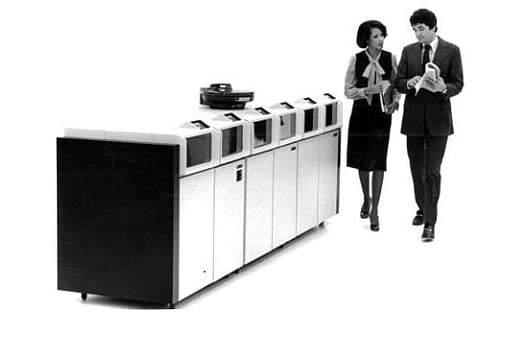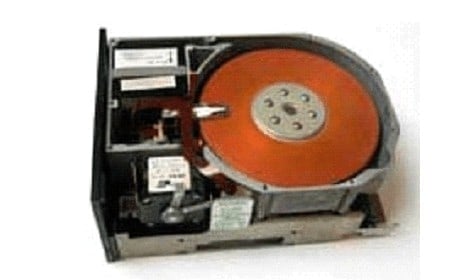5 Facts about Hard Disk
- A hard disk contains numerous substances.
- Hard disk typically has limited spaces.
- The world’s smallest hard disk was invented in 2016 by Dutch scientists.
- Hard disks aren’t airtight.
- Hard drives can be easily passworded.
Hard Disk History
Hard disks, otherwise regarded as hard drives or disk drives, are magnetic disks used to store and retrieve computer data.
The hard disk drive was first produced by IBM in 1956 and shipped as a component of the IBM 305 Random Access Memory Accounting (RAMAC) system in 1957. Created initially as a 35 Disk Storage Unit, Hard Disks consisted of the magnetic disk memory unit with its access mechanism, the electronic and pneumatic controls for the access mechanism, and a small air compressor.
Quick Facts
- Created
- 1956
- Creator (person)
- Reynold B. Johnson, IBM
- Original Use
- Secondary storage device for multipurpose computers
- Cost
- $10,000
Assembled with covers, it was 150cm long, 170cm high, and 72cm deep. It was configured with 50 24-inch magnetic disks containing 50000 sectors, each of which held 100 alphanumeric characters, for a total capacity of 5 million characters.
The Disks rotated at 1200 rpm, tracks (20 to the inch) were recorded at up to 100 bits per inch. The execution of a “seek” instruction positioned a read-write head to the track that contained the desired sector and selected the sector for a later read or write operation. Seek time averaged about 600 milliseconds. IBM originally sold their first produced hard disks at $10000 per Megabyte.
Over the next several years, as external and internal storage memory continued to evolve, the HDD would emerge as the next new, more adaptable solution and replace many of the earlier, groundbreaking storage technologies.
During the first several decades of developing hard disk drives, IBM was the leading innovator: in 1961, it invented heads for disk drives that “fly” on a cushion of air or on “air bearings.” In 1963 it came up with the first removable hard drive, 1311, which has six 14-inch platters and holds 2.6MB. In 1966 it introduced the first drive using a wound-coil ferrite recording head. In 1973, IBM introduced the 3340 or Winchester Direct Access Storage Facility. The smaller and lighter 3340 marked the next natural evolutionary step in hard disk storage.

In fact, IBM also continued to decrease the size of the disks and the platters. In 1979 IBM’s 3370 used seven 14-inch platters to store 571MB, the first drive to use thin-film heads. In the same 1979, IBM’s “Piccolo” was introduced, which uses six 8-inch platters to store 64MB.
Hard Disk: How It Worked
As mentioned earlier, hard disks store and retrieve computer data using magnetic storage. Nowadays, almost all computers and servers contain one or more hard disks, thanks to the capabilities of these disks to store digital data relatively permanently, allowing your computers to remember information even after the power goes out.
To understand how hard disks work, let’s carefully examine the construction of a typical hard drive below:

The hard disk uses round, flat disks called platters, coated on a magnetic medium, which stores information as magnetic patterns. The platters are stacked and mounted onto a spindle. Driven by a unique motor connected to the spindle, the platters rotate at very high speed (up to 15000 RPM revolutions per minute).
Electromagnetic read/write heads are used to write onto or read information from a disk platter. The read/write head is mounted on the arm, whose position is controlled by an actuator. A logic board controls the drives activities and communicates with the connected computer system.
Hard disks store data in binary codes, using 0s and 1s. To store any information, the disk(s) spread such info out on its magnetic layer and are written or read by the read heads floating above the surface with the aid of the air layer generated by the ultra-fast disk rotation.
The disk controller interprets the data to read from or send to the hard drive, letting the hard drive know what to do and how to do them.
Hard Disk: Historical Significance
As mentioned earlier, IBM introduced the first commercially sold hard disks in 1956, and since its introduction, it served as the dominant external storage device for multipurpose computers, especially in the early ‘60s.
The originally manufactured hard drive size was equivalent to that of two (2) refrigerators. However, it could only hold 5MB of data despite its size. With time, IBM continued decreasing the size of the disks and the platters. For instance, in 1979, IBM’s 3370 used seven 14-inch platters to store 571MB, the first drive to use thin-film heads. In that same 1979, IBM introduced “Piccolo,” which uses six 8-inch platters to store 64MB.
In 1980, a new and unknown company made a small revolution in hard disk drives production. Till then, only large and well-funded companies could afford to buy a hard disk, but now it has become possible for the broader public.
Alan Shugart and Finis Conner founded Seagate Technology in 1979, under the name “Shugart Technology.” Their first product, released in 1980, was the ST-506. That was the first hard disk to fit the 5.25-inch form factor of the Shugart “mini-floppy” drive. The ST506 held just 5MB of data and cost $1500; nonetheless, it was a hit and was later released in a 10-megabyte version, the ST-412.

In 1983, Rodime released the world’s first 3.5-inch hard drive. The company engineers used the 3.5-inch form factor of the floppy disk drives; the hard disk includes two platters and stores 10MB.
In 1998 IBM announced its Microdrive, the smallest hard drive to date, designed to fit in a CompactFlash (CF) Type II slot. It was launched in 2 models —170 MB and 340 MB.
In 2007, over 90% of all new information produced in the world was stored on magnetic media, most of it on hard disk drives. From an original capacity of 5 MB, a typical hard disk storage capacity now reaches several Terabytes.
Also, from 24-inch platters of the first hard disk drive, you can now buy a hard disk drive with 0.8-inch platters. Similarly, the value for money has increased dramatically: from $2000 per Megabyte during the original release to approximately $0.0004 per Megabyte in 2007.

